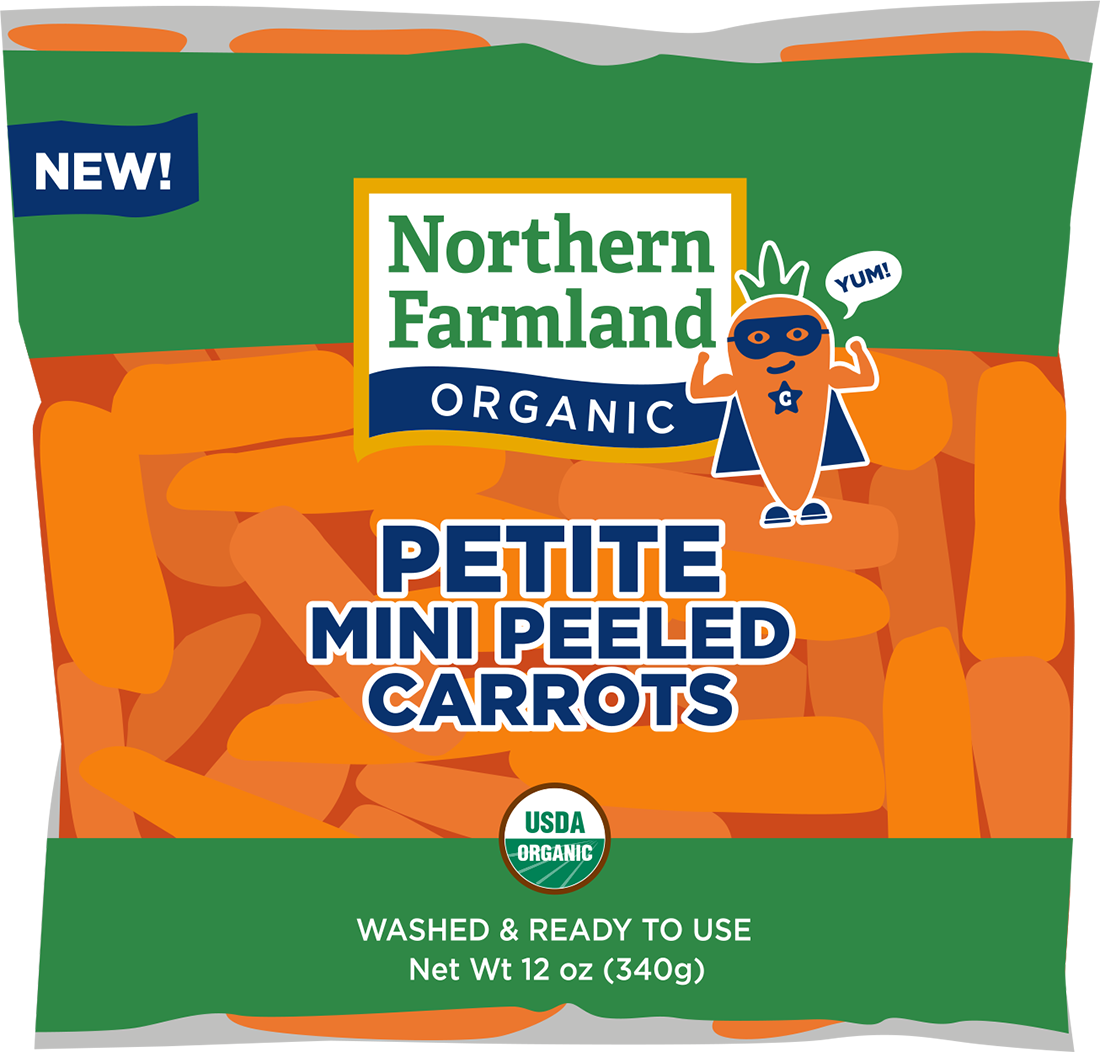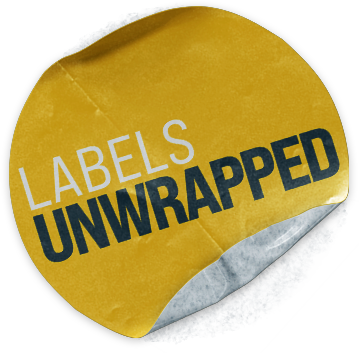Produce
Label claims for fruits and vegetables.
Produce Food Labels Overview
Fresh fruits and vegetables are generally considered raw agricultural commodities, or RACs, and exempt from typical nutrition labeling requirements. FDA defines “raw agricultural commodity” as “any food in its raw or natural state, including all fruits that are washed, colored, or otherwise treated in their unpeeled natural form prior to marketing.” For example, whole apples, oranges, and bananas purchased in the produce section of your grocery store are likely RACs because they are sold in their natural raw state. FDA also considers single-ingredient packaged produce “raw” if it has been cut or trimmed, like carrot sticks and mixed salad greens. Multi-ingredient produce or single-ingredient produce that has been cooked, treated, or processed in some way, such as dried fruit, frozen fruit, salad mixes with dressing or croutons, and caramel apples, are not considered “raw.” Food labels for raw agricultural commodities may appear directly on the food, or retailers may place the labels on signs, posters, or posters next to the food.
Whether the food is considered raw or not, if the produce label makes any nutritional claims or provides any nutritional information, the label must include a panel of nutrition facts, much like the nutrition facts found on other food labels. If the RAC does not include any nutrition claims or other nutrition information, the only mandatory labeling requirement is USDA’s country of origin labeling (COOL) requirements (available at USDA regulations). COOL is a labeling law requiring retailers to notify customers about the source of different foods.
While FDA does not require much labeling information, producers may still voluntarily include more information. Some voluntary information is regulated, such as how the Nutrition Facts Label may appear. Some voluntary information is not specifically regulated. For example, price look-up (PLU) codes are also often found on raw produce, but they are not regulated by the government. PLU codes are assigned by the International Federation for Produce Standards to improve supply chain efficiency of produce by harmonizing international standards. Below are some other labels you might see on processed (e.g., canned, frozen, or dried) fruit or vegetable products.
Interactive Label
Organic
This term means that a product has been produced according to the standards in the Organic Foods Production Act (OFPA) and certified by USDA’s National Organic Program. A label may only use the “USDA Organic” seal if the food is actually certified organic. However, a package may still note which ingredients, or percentage of ingredients, are USDA organic. Some producers, such as organic farmers who sell less than $5,000 in food per year may also market their products as organic without certification.Statement of Identity (Mini peeled Carrots)
A statement of identity is an established name for a food. The statement of identity serves to ensure that consumers know what food they are purchasing and to avoid confusion or misrepresentation. For more information see FDA regulations.Net Contents Quantity
Food packages must show the net contents of the package. The package must have the statement in both the US Customary System (e.g., ounces or pounds) and metric units (e.g., kilograms). For more information, see the FDA Food Labeling Guide.
Produce Food Label Claims
Bioengineered foods are “[t]hose that contain detectable genetic material that has been modified through certain lab techniques and cannot be created through conventional breeding or found in nature,” as defined in the National Bioengineered Food Disclosure Standard. Beginning in 2022, certain foods as established by the USDA Agricultural Marketing Service will need to disclose the presence of bioengineered ingredients. See our issue brief “Consumer’s Guide to Bioengineered Food Disclosures” for more information.
Neither FDA nor USDA have defined “conventional”; however, it is typically used to refer to food not grown through organic production methods. So, conventional foods may be grown using chemical fertilizers, pesticides, or genetically modified organisms.
FDA permits “good source of” claims if the food contains between 10 and 19 percent of the reference daily intake or daily reference value ordinarily consumed. See FDA regulations for more information.
FDA permits the use of “high” claims when the food contains 20 percent or more of the reference daily intake or daily reference value ordinarily consumed. The label should also clearly indicate the food that is the subject of this claim. Similar claims that may be made for the same purpose include “rich in” and “excellent source of.” See FDA regulations for more information.
This claim is not regulated by USDA. Generally, this term means the food was grown, raised, or produced close to the point of sale or within a certain region. USDA has some definitions for “local” that are used in other contexts. For example, USDA’s Rural Development loan program defines a “locally or regionally produced agricultural food product[]” as “a food product raised, produced, and distributed within 400 miles of its origin or within the same state.” However, there is no specific definition for the term “local” on food labeling, so this claim is subject to the producer’s interpretation, so long as it is not false or misleading.
Food packages must show the net contents of the package. The package must have the statement in both the US Customary System (e.g., ounces or pounds) and metric units (e.g., kilograms). For more information, see the FDA Food Labeling Guide.
Genetically engineered fruits and vegetables have had their genetic composition altered in some way. For non-GE foods, FDA recommends that manufacturers do not claim the food is “free” of ingredients derived through the use of biotechnology. Instead they recommend the use of terms such as “not bioengineered,” “not genetically engineered,” and “not genetically modified through the use of modern biotechnology” because even plants achieved through traditional methods are technically genetically modified through selective breeding.
For GE foods, FDA recommends producers use statements such as “genetically engineered” or a statement such as “This product contains cornmeal from corn that was produced using modern biotechnology.”
“GMO” stands for “genetically modified organism.” While there are no USDA or FDA regulations that specifically define this claim, both agencies have working definitions of “genetic modification.” USDA defines “genetic modification” as “[t]he production of heritable improvements in plants or animals for specific uses, via either genetic engineering or other more traditional methods.” FDA’s longstanding position on the term “GMO” is that even traditional plant breeding methods, like selective breeding, fall under “genetic modification.” FDA guidance recommends that producers do not use the term “non-GMO” and instead use terms like “not produced using modern genetic engineering” because consumers may not realize that traditional plant breeding methods can be considered genetic modification and that the majority of foods “do not contain entire organisms.” However FDA has stated that it does not intend to take action against producers that use these label claims “as long as the food is, in fact, not derived from a genetically engineered plant and the food’s labeling is not otherwise false or misleading.” FDA considers it misleading for any label that implies that food without genetically engineered ingredients is in any way superior to those products without a similar label. FDA considers food that is certified 100 percent organic to satisfy the non-GMO standard. Third-party certifiers (e.g., the Non-GMO Project) also have a set of standards for certifying non-GMO products.
This term means that a product has been produced according to the standards in the Organic Foods Production Act (OFPA) and certified by USDA’s National Organic Program. A label may only use the “USDA Organic” seal if the food is actually certified organic. However, a package may still note which ingredients, or percentage of ingredients, are USDA organic. Some producers, such as organic farmers who sell less than $5,000 in food per year may also market their products as organic without certification.
Organic products are grown and processed according to federal standards on soil quality, pest and weed control, and use of chemical fertilizers, among other areas. According to USDA, “[o]rganic producers rely on natural substances and physical, mechanical, or biologically based farming methods to the fullest extent possible.” Additionally, the use of genetically modified organisms is “prohibited in organic production or handling.”
The amount of organic ingredients in a food matters for labeling. A “100 percent organic” product may only have ingredients that are organic. A food that has at least 95 percent organic ingredients may have the term “organic” on its label if the organic ingredients are specifically noted somewhere on the package. If the product has at least 70 percent organic ingredients, the package may use the term “organic” to list the specific qualifying ingredients, but may not use the “USDA Organic” seal. Foods with organic ingredients, but less than 70 percent organic, may only use the term “organic” in the ingredient list or the percentage of organic ingredients. For more information on organic ingredient labeling, see the USDA Organic Labeling Standards website.
A statement of identity is an established name for a food. The statement of identity serves to ensure that consumers know what food they are purchasing and to avoid confusion or misrepresentation. For more information see FDA regulations.
